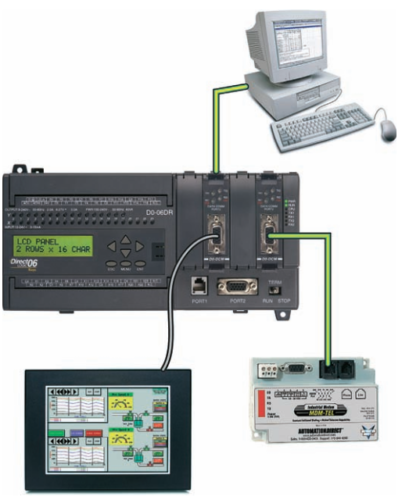Many different types of I/O modules have been developed to meet special needs.
HIGH-SPEED COUNTER MODULE

The high-speed counter module is used to provide an interface for applications requiring counter speeds that surpass the capability of the PLC ladder program. High-speed counter modules are used to count pulses from sensors, encoders, and switches that operate at very high speeds. They have the electronics needed to count independently of the processor. A typical count rate available is 0 to 100 kHz, which means the module would be able to count 100,000 pulses per second.
THUMBWHEEL MODULE

The thumbwheel module allows the use of thumbwheel switches for feeding information to the PLC to be used in the control program.
TTL MODULE

The TTL module allows the transmitting and receiving of TTL (Transistor-Transistor-Logic) signals. This module allows devices that produce TTL-level signals to communicate with the PLC’s processor.
ENCODER-COUNTER MODULE

An encoder-counter module allows the user to read the signal from an encoder on a real-time basis and stores this information so it can be read later by the processor.
BASIC OR ASCII MODULE

The BASIC or ASCII module runs user-written BASIC and C programs. These programs are independent of the PLC processor and provide an easy, fast interface between remote foreign devices and the PLC processor. Typical applications include interfaces to bar code readers, robots, printers, and displays.
STEPPER-MOTOR MODULE

The stepper-motor module provides pulse trains to a stepper-motor translator, which enables control of a stepper motor. The commands for the module are determined by the control program in the PLC.
BCD-OUTPUT MODULE

The BCD-output module enables a PLC to operate devices that require BCD-coded signals such as seven-segment displays.
PID MODULE

The proportional-integral-derivative (PID) module is used in process control applications that incorporate PID algorithms. An algorithm is a complex program based on mathematical calculations. A PID module allows process control to take place outside the CPU.
This arrangement prevents the CPU from being burdened with complex calculations. The basic function of this module is to provide the control action required to maintain a process variable such as temperature, flow, level, or speed within set limits of a specified set point.
MOTION AND POSITION CONTROL MODULE

Motion and position control modules are used in applications involving accurate high-speed machining and packaging operations. Intelligent position and motion control modules permit PLCs to control stepper and servo motors.
These systems require a drive, which contains the power electronics that translate the signals from the PLC module into signals required by the motor.
COMMUNICATION MODULES

Serial communications modules are used to establish point-to-point connections with other intelligent devices for the exchange of data. Such connections are normally established with computers, operator stations, process control systems, and other PLCs. Communication modules allow the user to connect the PLC to high-speed local networks that may be different from the network communication provided with the PLC.
